Let’s say you run a relatively small Twitter account with something like 250 followers. You try to improve your marketing over time, but it’s slow going; growth without paid investment is a long, organic process. You grow, but you have relatively average Twitter metrics. It’s fairly difficult to get a ton of engagement, and your tweets only get anywhere from 50-100 impressions, with a meager 1-5 likes, retweets, and replies. Only your best tweets seem to break 200 impressions or get over a dozen or two acts of engagement.
So it can come as a surprise and a shock to log into your Twitter analytics and see, one day, that a single tweet you made has racked up 5,000 impressions. Where the heck did all of those impressions come from?
How Twitter Defines Impressions
It’s difficult to dig through Twitter’s help system to find definitions of specific terms, but I happened to find a mention of impressions on a support page about their analytics and how to use it. Specifically, they say Impressions are “times a user is served a Tweet in timeline or search results.”
There are a few things worth noting about this. Remember, whenever you post a tweet, that tweet will show up in the feeds of the people who follow you. However, it will also become available in Twitter search, particularly if you’ve used any keywords of a type people search. It will also show up in feeds for hashtags, though in the faster moving hashtags it might not be visible due to curation. It depends if the people browsing the hashtag view it by “top” or by “latest,” or one of the other filtering options.
On top of this, a tweet is shown in the feeds of the followers of anyone who retweets your tweet. This is why influencer marketing is so important; a retweet from someone with 50 followers isn’t going to be worth much, while a retweet from someone with 50,000 followers is going to be worth a lot more.
Also, an impression might not actually mean a person saw the tweet. If I load my Twitter feed and then get distracted by something and close it, I probably gave +1 impression to a 20+ tweets without actually reading any of them. No bonus engagement, no interaction of any kind, but an added impression across the board.
Impressions also don’t care who the viewer is. If I go to your Twitter profile and hammer the F5 key a hundred times, I would be adding a hundred impressions to the tweets that load. At least, that’s how I presume it would work, unless Twitter has added a filter for that. Some sites don’t count a repeat impression from the same person in the same session, specifically to avoid showing inflated states like that.
Fortunately, Twitter doesn’t count your own impressions on your own tweets. You can’t hammer the F5 key to refresh your browser on your own profile to boost your stats.
Also, you should not conflate impressions and reach. Impressions are the number of views a tweet receives; reach is the number of people who see it. Reach will always be a lower number than impressions for this reasons. Anyone who sees the tweet twice will be worth two impressions, but only one reach.
Do Impressions Matter?
The thing about impressions is that they’re kind of inconsequential. You can see them in your own analytics, but no one else can see the impressions a given tweet has gotten. Other forms of engagement, like retweets and likes, are visible to the public. There’s no real reason to inflate impressions since they don’t do anything but skew your engagement rates in your own analytics.
There’s a correlation between more impressions and more engagement, of course, though it’s fairly low. On a test account I have a tweet that got nearly 8,000 impressions – when the account’s tweets generally average under 100 – due to a brief encounter with an influencer in the niche. That tweet received 158 engagements.
It’s even worse if you just try to calculate engagements yourself. Engagement on Twitter consists of more than just replies, retweets, and likes. Clicks on the image or other media you post, clicks to expand the full tweet, clicks of the link, and clicks on your profile all contribute as well. Of those 158 engagements, only 12 were retweets, 29 were likes, and zero were replies.
Impressions are good as a benchmarking system. If your tweets average 150 impressions each time you post, and you sign on and see one got 1,000 impressions, you know it went somewhere. From there, you can track down specifically WHY it received so much attention, and figure out how to replicate that effect.
Why Your Tweet Got So Many Impressions
So what are the possible reasons why your tweet might have gotten an unexpectedly large number of impressions?
There are a lot of potential causes.
- Your tweet lined up with a trending topic. Trending topics by definition have a lot of traffic, which is what causes them to trend – excepting paid trends, of course. If you tweeted about something extremely popular, other people who are tweeting about and reading about that topic are likely to be browsing the hashtag or the search results, and will see your tweet. Now, whether or not they engage with it is a different story.
- Your tweet was retweeted by or .replied (publicly replied) to by someone with a lot of followers. Again, influencer marketing is at play here. The more followers someone has, the more impressions they deliver when your content is shared. The small-scale influencer who caused the 7,800 impressions on my test tweet only has 5,000 followers themselves, but their influence spreads. Each of those 5,000 people – or however many of them are active – has the chance to retweet and further share the tweet with their followers, and so on.
- Your tweet was mentioned or featured somewhere else outside of Twitter. If I link to a specific tweet in this blog post, any of you who click on it become new impressions for the tweet. If I embed the tweet so it loads when you load the page, that’s an impression that doesn’t even require a click. A tweet mentioned or embedded in a Buzzfeed article, something on Distractify, or one of those other “soft plagiarist*” sites can lead to a lot of impressions.
- Your tweet was featured as a screenshot in a video or image compilation, like the many, many Twitter dumps on Imgur. You don’t get impressions from these, but if someone chooses to look up your account or the specific tweet, or if the dump poster includes source links, you can get impressions that way, albeit in a much slower fashion.
As far as that * goes, a lot of sites like Buzzfeed, Distractify, Upworthy, Knowable, and basically anything else George Takei links to on Facebook make their living stealing content with sources. If you visit, you’ll see most of their content is either a series of Twitter embeds with a vague story around it, a list made up of Reddit posts taken from some random thread, or some other compilation of content from other sites. Oh, it’s not plagiarism because all of the quotes have sources, but the sites in question put very little effort into actually creating their own content. It’s all 100% fish-in-a-barrel curation.
So, as you can see, impressions basically just come from people seeing the tweet and sharing it in a way that enables other people to see the tweet. The larger the audience, and the larger the influencer that picks it up, the greater the cascade of impressions becomes.
How to Get More Impressions on Your Tweets
If you want more impressions, you need to encourage the above methods of getting impressions. If all you want are total account impressions, all you really need to do is post more often. If you want more impressions per tweet, you need to put more effort into those tweets. Here are my tips, in no particular order.
Tweet when your audience is most active. Twitter’s timeline is largely, well, time-based. If you tweet at 3pm and I don’t sign on until 5pm, I see all those tweets that happened in the previous two hours before I see yours. The exception is if I’m engaged enough with you that your tweets show up under the curated section at the top, but you can’t be guaranteed to have that kind of engagement with all of your fans. Tweet during peak hours and you’ll get more visibility naturally.
When are your peak hours? I recommend using a tool like Tweriod to analyze your particular followers and see. Particularly with smaller audiences, you can vary a lot from what the average on Twitter is across the board.
Tweet more often. I know I said this is a technique for account-wide impressions, but it’s also valuable because it gives you more content for people to see. The more you post, the more chances you have for going viral, which will dramatically increase impressions and can earn you a lot of new followers. Experiment with your tweets; try different methods of tagging people, different hashtags, different levels of formality, uses of emojis and symbols, different topics, and anything else you can think of to test. Sooner or later something has to work, right?
Encourage engagement, particularly retweets. This can be as simple as just asking “please retweet” or as complex as running a user engagement contest. However, you need to make sure when you ask for engagement, you’re asking for a reason. I can’t just post a moderately funny joke and ask for retweets; I need to have some kind of purpose. The ASPCA does this with pets; they post a picture of an animal up for adoption, mention that it’s available, and ask people to retweet it to potentially find a home for the creature.
The core of influencer marketing is to get retweets from people, but it’s kind of its own beast. With influencer marketing, you need to figure out what kinds of content the users like and tend to retweet the most. A blog writer might like it when you link to their blog in yours, and will retweet a post where you tag them. An artist might like accolades, proof that you mentioned them somewhere, or fanart if you’re in a position to create it from your account. Finding the kind of content they like is essential to getting them to retweet it.
Make heavy use of hashtags. Twitter is not the place to be shy with tagging your posts. Yes, you have a character limit, and yes, you can only include 1-3 hashtags in a post before you start seeing lower returns. However, you should learn how to pick and use hashtags to your advantage. I recommend always aiming for something trending or at least highly trafficked whenever possible. Go ahead and read this guide for more information and strategies revolving around hashtags.
Consider investing a little money. With impressions, a little cash can go a long way, for one simple reason: if your objective for your ads is something other than impressions, the impressions you get are free. If you’re paying for link clicks, Twitter isn’t going to charge you for the people who see your ad and don’t click the link. Ads are excellent in a lot of ways, but simple impressions can build a lot just based off of a few dollars of investment each week.
What are your favorite ways to boost your impressions? Have you ever had something go viral unexpectedly? Tell me about it, I’m curious what the typical experience of my readers happens to be.
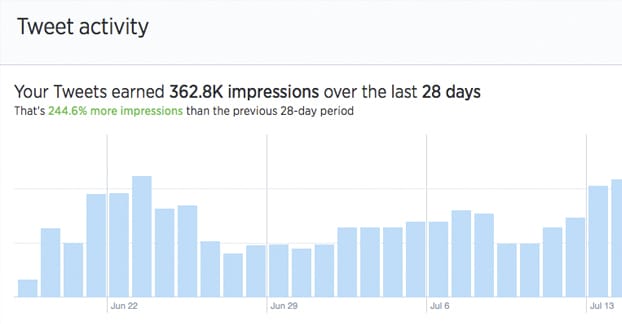

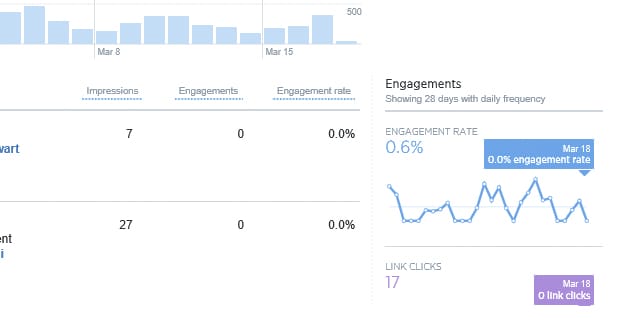
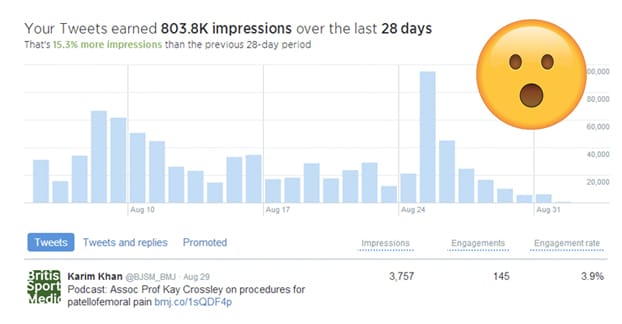
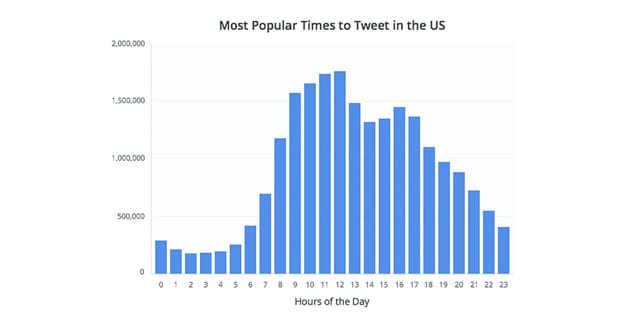
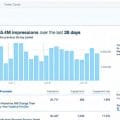
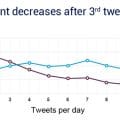


mec os
says:twitter does count your impressions on your own tweets and all your interactions with your own tweets. i actually wish it didn’t as eveytime i refresh my page, all my tweets impression counts goes up.
Mik b
says:I have a Twitter account that I use for writing little ‘bits’ of poetry. I do it as a creative outlet. I have no followers yet, in the last 24 hours its telling me I’v received 4,000 impressions. lol So clearly, something isn’t right.
James
says:In other words, “impressions” are the amount of times that someone has scrolled by your tweet and ignored it!
James Parsons
says:Hey, you’re not wrong 🙂 people scroll through their tweets so fast, they dont even have to read it and if they scroll by it counts as an impression. Some of my tweets get 20-30,000 impressions and maybe 20-30 likes. Go figure.
Michael J. Luna
says:I currently have 40 followers on my Twitter account. In April 2019 I have earned 101 link clicks, 44 retweets, 182 likes, 52 replies, and the engagement rate is 0.8%. In May of the same year, I have earned 18 link clicks, 2 retweets, 25 likes, 2 replies, and the engagement rate is 0.5%. As you all can see my “likes” declined by 157, and the “link clicks” declined by 83. So, during a 30 day period in April I have earned 2.4K impressions, and in a 28 day period in May I have earned 831 impressions. Yes, something is not right and I am not sure how Twitter calculates impressions.
Loren Amelang
says:At the top of my Analytics: Tweet activity Your Tweets earned 7.3K impressions over this 28 day period During this 28 day period, you earned 163 impressions per day. (That’s 4564…) But if I add up the Impressions shown beside each of the Tweets and replies listed below the graph (the same count of tweets as shown in the graph), I get 1559! I can believe 1559, but where do all the other headline Impressions come from? This is not unusual, it has been this mysterious since I first looked at Analytics.